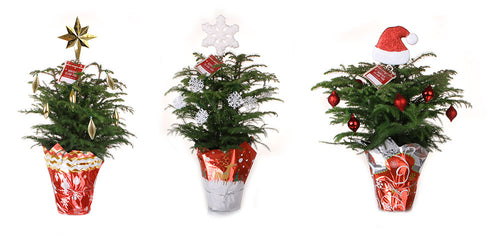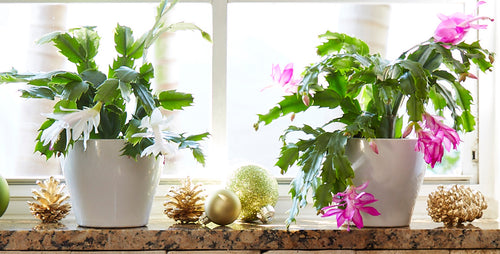Poinsettias are a longtime favorite holiday décor item because of their bright red color. But did you know they come in a variety of shapes, sizes and colors?

Variegated poinsettias
offer multicolor texture. The old jingle bells types (with red leaves splashed with white) are some of the most common, but you’ll also see pink with white edges, red with white edges, white with pink speckles and more.
Tip:
Variegated poinsettias don’t require any special care -- treat them just like their single-color cousins (which means keeping the soil moist, but not wet and keeping the plants protected from hot and cold air drafts).
Mini poinsettias
are a relatively new trend. These charmers are grown in tiny pots and are perfect for using as place settings, centerpieces, and decorating your desk at work. You usually find them in red, but look hard and you may see them in a variety of other colors.
Tip:
Because their pots are so small, you may need to water mini poinsettias a little more often than their larger cousins.


White poinsettias
are not new, but many people have never noticed them before. They add an elegant, refined touch to home décor, especially when used with silver or blue color schemes. Of course, they’re brilliant with red, too; you can’t go wrong mixing red and white poinsettias together!
Tip:
If you’ve avoided growing poinsettias in the past because of children or pets, you don’t need to worry. It’s a myth that poinsettias are poisonous. If consumed, they can cause a stomach ache, but they’re not toxic.
Tree poinsettias
are some of the most distinct poinsettias around. Growers train these poinsettias to grow straight up and only branch at the top, creating a lollipop look. You can find tree-form poinsettias in a variety of sizes, from tabletop to waist high, as well as in an array of colors.
Tip:
You can grow your own poinsettia tree just like the professionals do: just prune all the branches off one straight stem. Then when it gets the height you want, pinch the top of the plant off to make it grow a bushy canopy.
Poinsettia planters
create extra cheer and color by combining several types of plants. White chrysanthemums are a classic, as is Diamond Frost and other varieties of euphorbia. Other houseplants work, too -- such as the polka-dot plant shown here.
Tip:
If you make your own planters, be sure to pair varieties that have similar light, temperature, and water needs as poinsettias. That way both plants can look their best through the holidays.
Written by Justin Hancock

















